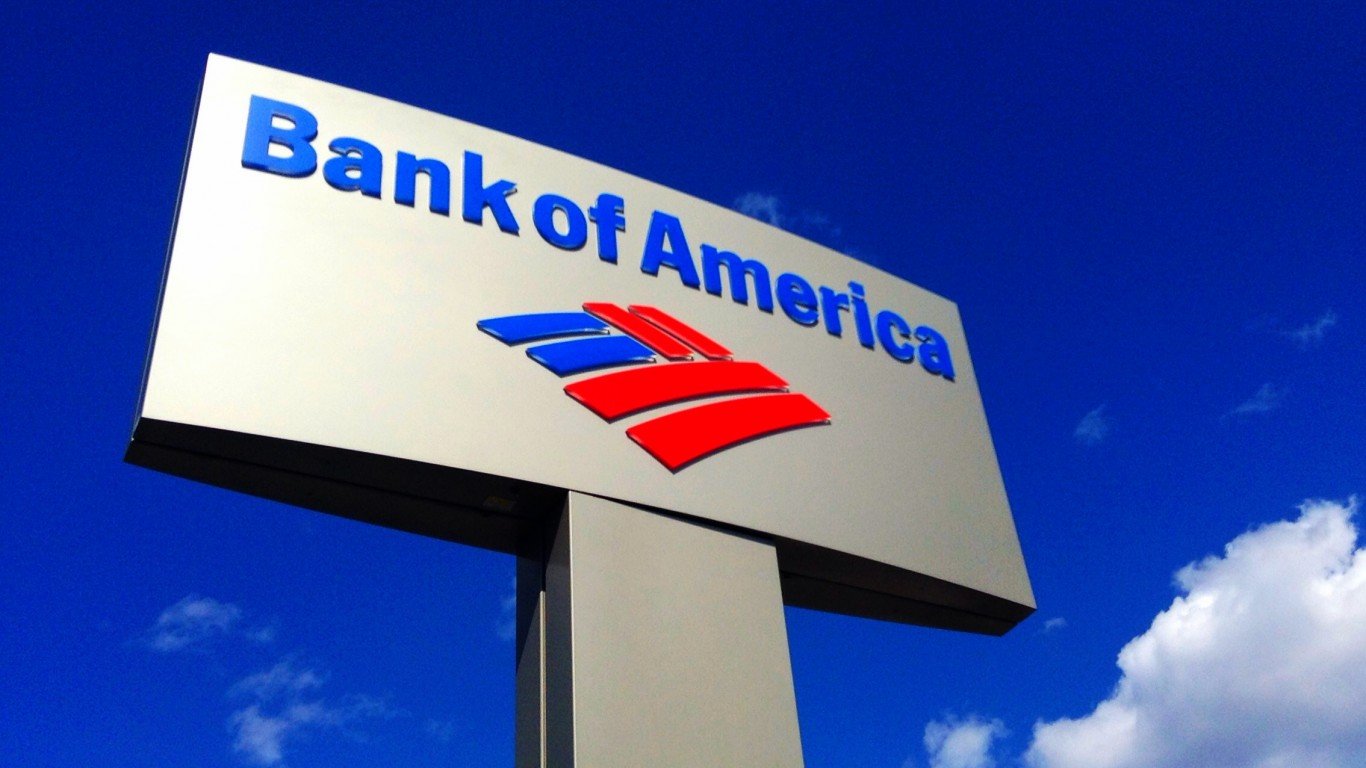

Bank of America (NYSE: BAC), a cornerstone of the American financial system, navigates a diverse landscape of consumer banking, wealth management, global banking, and markets. The stock is currently trading around $33.20. As we peer into the uncertain economic future, a crucial question lingers: where will BAC’s stock price land by 2030? To answer this, we must embark on a voyage through three potential scenarios: the optimistic bull case, the moderate base case, and the turbulent bear case.
Bull Case: Riding the Wave of Expansion and Innovation

Imagine a scenario where BAC’s net interest income flourishes, its wealth management arm thrives, and the Mergers & Acquisitions (M&A) scene brims with activity. This optimistic outlook paints a picture of continued digital banking leadership, with BAC capturing an even larger share of the retail deposit market. International ventures blossom, potentially pushing non-U.S. revenue to a quarter or even a third of the total pie. In this rosy vision, fueled by an anticipated 5-7% annual EPS growth, BAC’s stock price could soar to around $70 by 2030, with a P/E ratio expanding to a comfortable 13-15x.
The bull case paints a dynamic picture of Bank of America, not just riding a wave of favorable economic conditions, but actively shaping its own destiny through innovation and expansion. Imagine a scenario where BAC doesn’t just maintain its digital banking leadership, but revolutionizes the industry with cutting-edge AI-powered financial tools, attracting a surge of new customers and deepening engagement with existing ones. This digital prowess translates into not just market share gains, but also the creation of entirely new revenue streams through subscription-based services and data-driven financial products.
On the wealth management front, imagine BAC leveraging its vast client base and expertise to become a go-to destination for sustainable and impact investing solutions. This caters to the growing demand from millennials and Gen Z who prioritize aligning their investments with their values. By attracting this demographic and offering innovative wealth management tools, BAC could unlock a significant new source of growth.
Furthermore, the global expansion envisioned in the bull case isn’t merely about replicating the domestic model overseas. It’s about strategically acquiring niche players in high-growth emerging markets, gaining access to untapped customer segments and diversifying revenue streams. Imagine BAC becoming a key player in Southeast Asia’s burgeoning fintech scene or expanding its footprint in Africa’s mobile money revolution. Such targeted acquisitions, coupled with organic growth, could propel BAC’s international presence to a whole new level, exceeding the 25-30% revenue mark and solidifying its position as a truly global financial powerhouse.
This enhanced bull case goes beyond simply hoping for favorable economic winds. It paints a picture of BAC actively steering its own course through innovation, strategic expansion, and a deep understanding of evolving customer needs. In this scenario, reaching $70 by 2030 wouldn’t just be possible, it could be the springboard for even greater heights.
Base Case: Anchoring in Economic Stabilization

Now, let’s consider a more temperate scenario in which the U.S. economy pulls off a soft landing by mid-decade, avoiding a recession and instead settling into modest GDP growth. The Federal Reserve plays a pivotal role, adjusting the Fed funds rate to stay below 6%. This strategic move grants businesses and consumers a bit of breathing room, fostering loan growth and potentially enhancing net interest income for BAC. However, the journey isn’t devoid of challenges. Geopolitical tensions and potential trade disruptions loom as significant headwinds, while persistent inflation may diminish consumer spending power, imposing constraints on economic momentum.
In this scenario, BAC adeptly navigates a delicate balance—net interest income and non-interest income achieve harmony, supported by digital efficiencies that help counterbalance potential dips in revenue. This scenario sets the stage for a steady ascent towards a $50 stock price, buoyed by capital returns and a P/E ratio that edges up to around 12. Though this path may lack the dazzle of the bullish scenario, it offers a beacon of stability and consistent performance. Such attributes make it particularly appealing to risk-averse investors in search of a dependable long-term asset.
To satisfy your curiosity about interest rates, check out How the Highest Mortgage Rate in Decades Compares to the Last 25 Years.
Bear Case: Bracing for Turbulent Headwinds

Brace yourselves for a potential economic downturn, where persistent inflation and aggressive monetary tightening trigger a protracted contraction in lending. This bleak picture sees pockets of credit deterioration, leading to higher loan losses. Global trade slows, geopolitical tensions escalate, and investment banking and capital markets activity plummet. The wealth management sector feels the pinch as investor confidence wanes, reversing asset flows. In this bearish scenario, a 15% annualized drop in EPS could send BAC’s stock price plummeting 30-40%, landing in the high $20s. However, a complete collapse seems improbable, given the bank’s robust deposit franchise, expense flexibility, and post-crisis safety measures. Extreme scenarios like dividend cuts or major write-downs appear unlikely, as BAC enters this potential storm from a position of relative strength. Nevertheless, investors must remain vigilant, monitoring net charge-offs, capital returns, and growth spending for any signs of trouble brewing.
Financial Overview: Bank of America

Bank of America’s financial performance over the past years provides a foundational context for understanding its future price predictions. To gain deeper insight into BAC’s future prospects, let’s examine its recent financial performance. Here’s a snapshot of revenue and earnings per share (EPS) over the past years:
| Year | Revenue (Million USD) | EPS (USD) |
|---|---|---|
| 2020 | 85,528 | 1.87 |
| 2021 | 89,113 | 3.56 |
| 2022 | 94,950 | 3.19 |
| 2023 | 94,187 | 3.08 |
This table showcases BAC’s resilience and growth trajectory, with steady increases in both revenue and EPS. Projections indicate further growth in the coming years, bolstering the optimistic outlook and providing a buffer against the bear case scenario.
The Verdict: A Journey Shaped by Economic Currents

At its current valuation, Bank of America is a titan ready to weather the storm. The company presents a compelling case for investors, offering a balance between risk and reward across economic cycles. Whether the stock price reaches the optimistic heights of $70, cruises steadily at $50, or encounters turbulence in the bear case, BAC’s journey towards 2030 will undoubtedly be influenced by broader economic currents, regulatory landscapes, and its strategic decisions in the ever-evolving banking environment. Investors must remain agile, adjusting their sails as the economic winds shift. The financial data underscores BAC’s ability to navigate diverse economic landscapes, reinforcing the potential for the bull case and providing a safety net in the bear case. Going forward, BAC’s adaptability and growth amidst evolving financial landscapes remain key factors in its stock performance.
Take This Retirement Quiz To Get Matched With A Financial Advisor (Sponsored)
Take the quiz below to get matched with a financial advisor today.
Each advisor has been vetted by SmartAsset and is held to a fiduciary standard to act in your best interests.
Here’s how it works:
1. Answer SmartAsset advisor match quiz
2. Review your pre-screened matches at your leisure. Check out the
advisors’ profiles.
3. Speak with advisors at no cost to you. Have an introductory call on the phone or introduction in person and choose whom to work with in the future
Take the retirement quiz right here.
Thank you for reading! Have some feedback for us?
Contact the 24/7 Wall St. editorial team.



